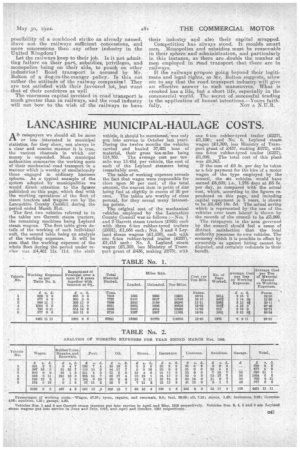LANCASHIRE MUNICIPAL-HAULAGE COSTS.
Page 41

If you've noticed an error in this article please click here to report it so we can fix it.
AS ratepayers we should all be more or less interested in municipal statistics, for they show, not always in a clear and concise manner it is true, the various channels in which our money is expended. Most municipal authorities summarize the working costs of their mechanical road transport in a manner which is worthy of emulationoby those engaged in ordinary business spheres.. As a typical example of the system adopted by municipalities we would direct attention to the figures published on this page, which deal with the working. operations of the fleet of steam tractors and wagons run by the Lancashire County Co-di-lea during the period ended March 31st.
The first two vehicles referred to in the tables are Garrett steam tractors, the remaining machines being Leyland steam wagons. The first table gives details of the working of each individual unit, the second table being an analysis of the working expenses. It, will be seen that the working expenses of the whole fleet during the period under review was 24,461 as. lid. (the sixth
vehicle, it should be mentioned,was only pat into service in October last, year). During the twelve months the vehicles carried and hauled 37,821 tons of material, their gross ten-miles being 114,760. The average cost per tonmile was 13.48d, per vehicle, the cost of each of the Leyland steamers being remarkably even.
The table of working expenses reveals the fact that wages were responsible for close upon 50 per cent, of the total amount, the nearest item in point of size being fuel at slightly in excess of 20 per cent. The tables are worthy of closo perusal, for they reveal many interesting points.
. The original cost of the mechanical vehicles employed by the Lancashire County Council was as follows :—Nos. 1 and 2 Garrett steam tractors (2986) each with three 6-ton rnbber-tyred trailers (2681), 21,666 each ; Noe. 3 and 4 Leyland steam wagons (21,188), each with one 6-ton rubber-tyred trailer (2227), 21,4-15 each ; No. 6, Leyland steam wagon (21,309, less Ministry of Transport grant of 2436, making 2873), with
one 6-ton rubber-tyred trailer (2227), 21,100; and No. 6, Leyland steam wagon (21,309, less Ministry of Transport grant of 2437, making 2872), with one 6-ton rubber-tyred trailer (2227),
21,099. The total cost of this plant was 28,363.
If the sum of 25 5s. per day be taken as a fair payment for the hire of. a motor wagon of the type employed by the council, the six vehicles would have earned 26,609, i.e,, 1,276 days at 25 5e. per day, as compared with the actual -cost, which, according to the figures reproduced on this page, and including capital repayment in 5 years, is shown to be 26,443 14s. 5d. The actual saving which is represented by the use of the,vehicles over team labour is shown by the records of the council to be L3,009.•
The ratepayers in the area governed br the council should feel a sense of distinct satisfaction that the local authority possesses its own vehicles. The economy which it is possible to effect by ownership as against hiring cannot be disputed, and certainly redounds to their benefit.












































